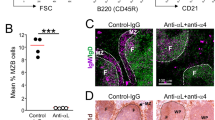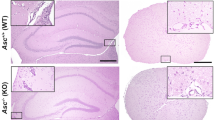Abstract
Following peripheral exposure to transmissible spongiform encephalopathies (TSEs), infectivity usually accumulates in lymphoid tissues before neuroinvasion. The host prion protein (PrPc) is critical for TSE agent replication and accumulates as an abnormal, detergent insoluble, relatively proteinase-resistant isoform (PrPSc) in diseased tissues1,2. Early PrPSc accumulation takes place on follicular dendritic cells (FDCs) within germinal centers in lymphoid tissues of patients with variant Creutzfeldt–Jakob disease3 (vCJD), sheep with natural scrapie4 or rodents following experimental peripheral infection with scrapie5,6,7. In mouse scrapie models, the absence of FDCs blocks scrapie replication and PrPSc accumulation in the spleen, and neuroinvasion is significantly impaired6,7,8,9. The mechanisms by which the TSE agent initially localizes to lymphoid follicles and interacts with FDCs are unknown. Antigens are trapped and retained on the surface of FDCs through interactions between complement and cellular complement receptors10,11. Here we show that in mice, both temporary depletion of complement component C3 or genetic deficiency of C1q significantly delays the onset of disease following peripheral infection, and reduces the early accumulation of PrPSc in the spleen. Thus, in the early stages of infection, C3 and perhaps C1q contribute to the localization of TSE infectivity in lymphoid tissue and may be therapeutic targets.
This is a preview of subscription content, access via your institution
Access options
Subscribe to this journal
Receive 12 print issues and online access
$209.00 per year
only $17.42 per issue
Buy this article
- Purchase on Springer Link
- Instant access to full article PDF
Prices may be subject to local taxes which are calculated during checkout



Similar content being viewed by others
References
Bueler, H. et al. Normal development and behaviour of mice lacking the neuronal cell-surface PrP protein. Nature 356, 577–582 (1992).
Bolton, D.C. et al. Identification of a protein that purifies with the scrapie prion. Further purification and characterization of scrapie prions. Science 218, 1309–1311 (1982).
Hill, A.F. et al. Investigation of variant Creutzfeldt–Jakob disease and other human prion diseases with tonsil biopsy samples. Lancet 353, 183–189 (1999).
van Keulen, L.J.M. et al. Immunohistochemical detection of prion protein in lymphoid tissues of sheep with natural scrapie. J. Clin. Microbiol. 34, 1228–1231 (1996).
McBride, P.A., Eikelenboom, P., Kraal, G., Fraser, H. & Bruce, M.E. PrP protein is associated with follicular dendritic cells of spleens and lymph nodes in uninfected and scrapie-infected mice. J. Pathol. 168, 413–418 (1992).
Brown, K.L. et al. Scrapie replication in lymphoid tissues depends on prion protein-expressing follicular dendritic cells. Nature Med. 5, 1308–1312 (1999).
Mabbott, N.A. et al. Tumor necrosis factor α-deficient, but not interleukin-6-deficient, mice resist peripheral infection with scrapie. J. Virol. 74, 3338–3344 (2000).
Mabbott, N.A., Mackay, F., Minns, F. & Bruce, M.E. Temporary inactivation of follicular dendritic cells delays neuroinvasion of scrapie. Nature Med. 6, 719–720 (2000).
Montrasio, F. et al. Impaired prion replication in spleens of mice lacking functional follicular dendritic cells. Science 288, 1257–1259 (2000).
Pepys, M.B. Role of complement in the induction of immunological responses. Transplant Rev. 32, 93–120 (1976).
Nielsen, C.H., Fischer, E.M. & Leslie, R.G.Q. The role of complement in the acquired immune response. Immunology 100, 4–12 (2000).
Pepys, M.B., Tompkins, C. & Smith, A.D. An improved method for the isolation from Naja naja venom of cobra factor (CoF) free of phospholipase A. J. Immunol. Methods 30, 105–117 (1979).
Papamichail, M. et al. Complement dependence of localisation of aggregated IgG in germinal centres. Scand. J. Immunol. 4, 343–347 (1975).
Botto, M. et al. Homozygous C1q deficiency causes glomerulonephritis associated with multiple apoptotic bodies. Nature Genet. 19, 56–59 (1998).
Taylor, P.R. et al. A targeted disruption of the murine complement factor B gene resulting in loss of expression of three genes in close proximity, factor B, C2, and D17H6S45. J. Biol. Chem. 273, 1699–1704 (1998).
Cutler, A.J. et al. T cell-dependent immune response in C1q-deficient mice: defective interferon γ production by antigen-specific T cells. J. Exp. Med. 187, 1789–1797 (1998).
Farquhar, C.F., Dornan, J., Somerville, R.A., Tunstall, A.M. & Hope, J. Effect of Sinc genotype, agent isolate and route of infection on the accumulation of protease-resistant PrP in non-central nervous system tissues during the development of murine scrapie. J. Gen. Virol. 75, 495–504 (1994).
Van den Berg, T.K., Dopp, E.A., Daha, M.R., Kraal, G. & Dijkstra, C.D. Selective inhibition of immune complex trapping by follicular dendritic cells with monoclonal antibodies against rat C3. Eur. J. Immunol. 22, 957–962 (1992).
Qin, D. et al. Evidence for an important interaction between a complement-derived CD21 ligand on follicular dendritic cells and CD21 on B cells in the initiation of IgG responses. J. Immunol. 161, 4549–4554 (1998).
Fearon, D.T. The complement system and adaptive immunity. Semin. Immunol. 10, 355–361 (1998).
Beringue, V. et al. Role of spleen macrophages in the clearance of scrapie agent early in pathogenesis. J. Pathol. 190, 495–502 (2000).
Tas, S.W., Klickstein, L.B., Barbashov, S.F. & Nicholson-Weller, A. C1q and C4b bind simultaneously to CR1 and additively support erythrocyte adhesion. J. Immunol. 163, 5056–5063 (1999).
Norsworthy, P.J., Taylor, P.R., Walport, M.J. & Botto, M. Cloning of the mouse homolog of the 126-kDa human C1q/MBL/SP-A receptor, C1qR(p). Mamm. Genome 10, 789–793 (1999).
Farquhar, C., Dickinson, A. & Bruce, M. Prophylactic potential of pentosan polysulphate in transmissible spongiform encephalopathies. Lancet 353, 117 (1999).
Wuillemin, W.A. et al. Potentiation of C1 inhibitor by glycosaminoglycans: dextran sulfate species are effective inhibitors of in vitro complement activation in plasma. J. Immunol. 159, 1953–1960 (1997).
Pepys, M.B., Dash, A.C., Fielder, A.H.L. & Mirjah, D.D. Isolation and study of murine C3. Immunology 33, 491–499 (1977).
Dickinson, A.G., Meikle, V.M. & Fraser, H. Genetical control of the concentration of ME7 scrapie agent in the brain of mice. J. Comp. Pathol. 79, 15–22 (1969).
Farquhar, C.F., Somerville, R.A. & Ritchie, L.A. Post-mortem immunodiagnosis of scrapie and bovine spongiform encephalopathy. J. Virol. Methods 24, 215–221 (1989).
Acknowledgements
We thank I. McConnell, D. Drummond, M. Brady and J. Foster for technical support. This work was supported by program and project grants from the Medical Research Council, the Biotechnology and Biological Sciences Research Council, and The Wellcome Trust (No. 054838).
Author information
Authors and Affiliations
Corresponding author
Rights and permissions
About this article
Cite this article
Mabbott, N., Bruce, M., Botto, M. et al. Temporary depletion of complement component C3 or genetic deficiency of C1q significantly delays onset of scrapie. Nat Med 7, 485–487 (2001). https://doi.org/10.1038/86562
Received:
Accepted:
Issue Date:
DOI: https://doi.org/10.1038/86562
This article is cited by
-
Unaltered intravenous prion disease pathogenesis in the temporary absence of marginal zone B cells
Scientific Reports (2019)
-
Analysis of RNA Expression Profiles Identifies Dysregulated Vesicle Trafficking Pathways in Creutzfeldt-Jakob Disease
Molecular Neurobiology (2019)
-
Reversible off and on switching of prion infectivity via removing and reinstalling prion sialylation
Scientific Reports (2016)
-
Global Protein Differential Expression Profiling of Cerebrospinal Fluid Samples Pooled from Chinese Sporadic CJD and non-CJD Patients
Molecular Neurobiology (2014)
-
The immunobiology of prion diseases
Nature Reviews Immunology (2013)



